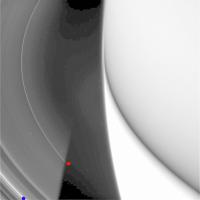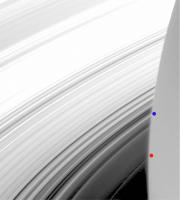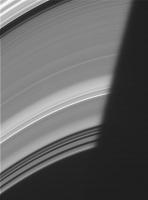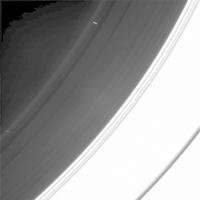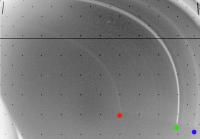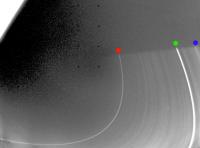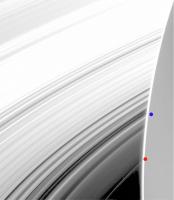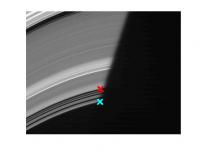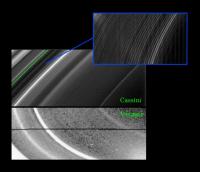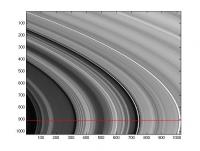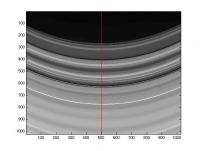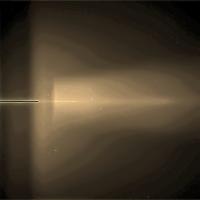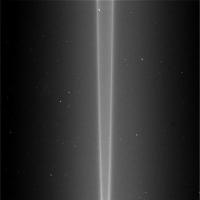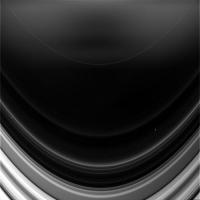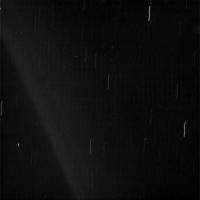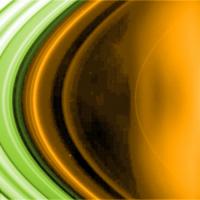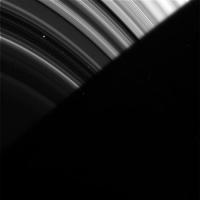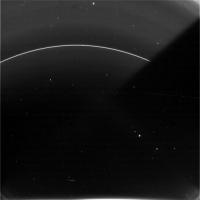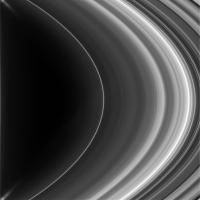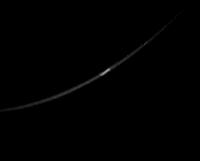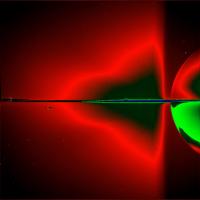Printable Version of Topic
Click here to view this topic in its original format
Unmanned Spaceflight.com _ Cassini's ongoing mission and raw images _ Faint Ring Thread
Posted by: Rob Pinnegar Jul 17 2005, 08:23 PM
There are two new "Raw Images" up that give a good view of Saturn's D Ring. As of today (July 17th) they are on the first page of the Raw Images section. The better of the two is image number W00009347.
The very narrow inner ringlet is called D68 and it is the innermost well defined ringlet of the entire ring system -- it's only about 7250 kilometres above the cloud tops, about half-way from the planet to the inner edge of the C Ring. If you search the "Saturn-D Ring" section of Raw Images, there is a nice narrow angle view (N00035241) which I am pretty sure is a close-up of D68. D68 is an oddball, it really is sort of "in the middle of nowhere".
The brighter ringlet in the upper right is called D73. About a thousand kilometres inward from D73, there is a noticeable "dark zone". In the Voyager images, there was a third bright narrow ringlet inside this zone, D72, which seems to be gone now, strangely enough. The relevant Voyager images are Voyager 1 image 34946.50, and Voyager 2 image 44007.53. If the diffuse ringlet at the inner edge of the "dark zone" is what is left of D72, it looks to have migrated a bit closer to Saturn in addition to spreading out a lot. (By the way, I'm not making up these ringlet designations on the fly -- they are given in a paper by Mark Showalter that was published in Icarus in 1996, which is pretty much the only major paper on the D Ring.)
To give some idea of scale, the three bands of material in the far upper right corner are part of the innermost ringlet of the C Ring (this can also be seen on some images of the rings taken on May 3rd of this year).
Since it is so faint and doesn't appear in many images, the D Ring rarely attracts much attention. But it's kind of neat to look at if you haven't seen it before, particularly because of D68, which is sort of the "anti-F ring" in a way.
Posted by: volcanopele Jul 17 2005, 08:30 PM
Thanks for the treatise on the D-ring. Are there any known causes for the D68 ringlet, what controls it? For the F ring you have Pandora and Prometheus, but I wonder what keeps D68 confined.
Posted by: Rob Pinnegar Jul 17 2005, 09:15 PM
There is some discussion of confinement mechanisms in the 1996 Icarus paper. Apparently D68 doesn't really need to be confined because its has so little mass. It seems that the rate of viscous spreading varies roughly linearly with opacity, and D68's opacity is very low. It can stay the way it is for eons without help from an outside source.
There are a couple of satellite resonances in the vicinity of D68 (one is the 3:1 Atlas resonance) but they are so weak that they probably aren't actually having any confining effect. It's also possible that the internal oscillation modes of Saturn itself could be involved in the D Ring structure -- in theory, these can play a "shepherding" role very similar to that of satellite resonances. (I don't claim to understand this, and am just trying to summarize part of the paper.)
I should probably add that my identification of the features in the new Cassini images as being the D68, D72 and D73 ringlets from the Voyager images is based entirely upon my own amateur analysis. I did my best to be careful, but the fact that my interpretation requires D72 to have virtually "vanished" over the last 25 years does make me wonder whether it is entirely valid.
Posted by: Ian R Jul 18 2005, 08:00 AM
Hi Rob,
What's the best way to get a copy of this paper on the D-ring? Is there an internet source where it can be located?
Speaking of the faint Saturnian rings, this is probably one of the best images of the G-ring ever taken:
http://saturn.jpl.nasa.gov/multimedia/images/raw/casJPGFullS07/W00004084.jpg
Posted by: Rob Pinnegar Jul 18 2005, 02:17 PM
Hi Ian,
That's a really nice shot of the G Ring. It has a very well defined inner boundary; I assume this must be due to a satellite resonance, but am not sure which one. Also there is a hazy band outside it that looks suspiciously like the E Ring, assuming it's not a glare artifact from Saturn and the main rings.
As for the Icarus paper, I did a quick look round the Internet and didn't find it anywhere, except for the abstract of course. I can give you the reference though: Mark R. Showalter, "Saturn's D Ring in the Voyager Images", Icarus 124, pp. 677-689 (1996). It's a pretty thorough treatment of the subject.
Do you have access to the Web of Science? If you have a university library card, and if your university subscribes to that journal, you ought to be able to download it from there. But Web of Science is sadly not available to the general public.
There are two good images of the D Ring in the Voyager images. The one taken by Voyager 2 is the one you'll normally find in Google searches because it has less smear. The nice thing about the Voyager 1 image though is that it includes the innermost part of the C Ring which gives a better idea of scale. I've attempted to attach that image to this post below (sorry if it doesn't work -- this is the first time I've tried attaching an image). Comparison with the recent Cassini image I've cited above shows the apparent changes in the outer part of the D ring. C3494650.BMP ( 626.05K )
: 972
C3494650.BMP ( 626.05K )
: 972
If I didn't know better, I'd be tempted to suggest that D72 has "migrated outward" and merged with D73. However, that just doesn't seem physically possible. We do have to keep in mind here that there are changes in apparent brightness of ring components due to viewing-angle effects. That's probably a contributing factor.
Cheers
Rob
Posted by: edstrick Jul 19 2005, 09:46 AM
After the historically known A, B and C rings, rings were named in order of discovery. The D ring was claimed to exist in or the mid 60's based on photography of Saturn with the rings wide open some years earlier. We know know that the detection was almost certainlhy false, and the apparant inner gap between the suspected ring and Saturns' disk was probably a photographic artifact. But the claim stuck the name to that "spot" in the rings. The E ring was claimed, I think by Dollfus, in 1966 edge-on pics of the rings and was a valid claim. Then the F-ring was imaged and detected by charged particle absorption by Pioneer 11. and the G-ring by Voyater, together with the *REAL* D-ring.
Perfect consistency?.. who cares!
Posted by: dvandorn Jul 19 2005, 10:19 AM
Besides, while each of these classic ring segments share some gross characteristics, they all show a certain amount of differentiation within the ring (especially in the large rings) and are made up of thousands of "ringlets." After having seen how many thousands of ringlets exist, it seems rather silly to speak of Saturn having "seven rings" (A through G). Maybe we should come up with another nomenclature -- something like "ring domains."
After all, there is precedent for changing nomenclature when we get higher resolution images of planets. Just look at Mars -- while some of the current naming conventions pay homage to the old names based on telescopic observations of the albedo patterns, the modern names are all rather different and now refer to the landforms we've only discovered in the last 30 or so years. If Sinus Meridiani can be transformed into two regions, Meridiani Terra and Meridiani Planum, then why can't Saturn's A ring be redesignated "Ring Domain A" with sub-domains reflecting variations in structure and composition?
And, just remember, for those who wax lovingly over the "olden days," we'll always have the Encke and Cassini Gaps...
-the other Doug
Posted by: Rob Pinnegar Jul 19 2005, 07:37 PM
[quote=dvandorn,Jul 19 2005, 04:19 AM]
After having seen how many thousands of ringlets exist, it seems rather silly to speak of Saturn having "seven rings" (A through G). Maybe we should come up with another nomenclature -- something like "ring domains."
There are probably a variety of ways that could be done. For example, I sometimes think of the three inner bands of the C ring (interior to the Titan ringlet) as the "C Minus" ring. There are places where that works a bit (C Ring outside the Maxwell gap as "C Plus", the darker inner part of the B ring as "B Minus", A ring outside the Encke gap as "A Plus" and so on).
I sure don't expect to see anyone else using this though. It's way too informal, and seriously limited. If you designate the outer third of a ring as "plus" and the inner third as "minus" how do you differentiate the middle third from the ring as a whole? Do you call it "C-Zero"? Yeccch. Besides that, it artifically assumes that rings are divided into thirds. It's okay as pet notation, but doesn't make the cut as _real_ notation.
My guess is that ring structures would be least ambiguously defined by (1) basic nature (ringlet vs. gap) and (2) radial distance from Saturn, though ellipiticity could throw a wrench into the second of these. So a ringlet at 73145 km would be R73145, a gap at 85000 would be G85000 and so on, possibly divided into sub-kilometre scale using decimals, i.e. R112730.3. But this would be really confusing for nonscientists, for whom the A-G system is probably best.
Posted by: Ian R Jul 21 2005, 07:33 PM
I have collected together the best images of the D-ring that I’ve been able to find, and labelled (where possible) the positions of the ringlets that Rob mentioned in his initial post to this thread:
- D68 ringlet (Red circle)
- D72 (Green circle)
- D73 (Blue circle)
I have omitted the D72 (Green circle) in some of the Cassini images, as according to Rob it seems to have either disappeared, or merged with another ringlet.
Two of the other Cassini images are absolutely puzzling and I cannot fathom them out. If anyone can help me identify what exactly is shown in the pictures labelled 'Cassini Puzzle', then I would be most appreciative.
Thanks,
Ian.
Posted by: Rob Pinnegar Jul 22 2005, 01:10 AM
Hi Ian,
Your identification of D68 and D73 in the Cassini images agrees with what I've come up with so far. For what it's worth, here's my interpretation of the two "puzzle" images (sorry this is so long, but I thought I ought to explain my reasoning):
Puzzle #1 is actually "mislabeled" as an image of the D Ring because almost all of the bright ring material shown is actually the innermost 1,500 kilometres or so of the C Ring. The part of the C Ring that lies interior to the Titan ringlet is about 3,000 kilometres wide in total, and can be roughly divided into three ringlets that have about the same width. The outer two of these are the brighter ones, and they are separated from the third innermost one, which dominates the Puzzle #1 image, by a gap which is visible in the upper left corner. If you look at other images of the inner C Ring you should be able to identify this interior ringlet by its appearance, which is quite distinctive.
The gap in the upper-left corner of Puzzle #1 is the same one that shows up in the lower-right corner of Puzzle #2. Notice that the four sub-ringlets at the inner edge of the C Ring match up in both images; the other C Ring details are obscured in the second image because they are overexposed. This means that the fairly prominent D Ring component (the one with the two starlines through it) in the second image is almost certainly D73. Some of the faint components of the outer D Ring that are very clear in other images don't show up all that well in this one. I suspect that this may be due to differences in the illumination angle, which seems to favour dust at backlit angles and larger particles at forward lit angles. (I don't have Mark Showalter's paper handy at the moment, but he did mention this there.)
Some of the other images in the D Ring section of the Cassini website (N34711-N34714) show a bunch of narrow bright ringlets clustered together. Unless I'm very wrong these are close-ups of the D73 region. D73 also appears at the top of image N35232. There is a diffuse ringlet at the bottom of that image which also seems to show up in image N35235. Presumably this is the same diffuse ringlet that can be seen interior to D73 in other Cassini images? I'm still not convinced that it is D72 though. It seems to have the wrong width, and it just doesn't seem to lie at the same distance from Saturn, when compared with the Voyager images. Close, but... no banana.
Cheers and happy hunting,
Rob
Posted by: Rob Pinnegar Aug 19 2005, 09:00 PM
Can't resist resurrecting this thread to point out the nice fully-processed shot of the D Ring which is currently up as the Cassini website's shot of the day. There are a number of features visible in this image that cannot be seen in any of the other wide-angle Cassini views (although they do show up in some of the narrow angle shots). The dust features are harder to see than in the Voyager images, but the resolution of narrow features is much, much better.
In reference to some of my previous posts here: I'm now pretty sure I was wrong about the D72 feature having completely disappeared. The broad feature at the inner edge of the "dark zone", which was visible in earlier Cassini images in addition to the new one, does in fact appear to be at the same distance from Saturn as the D72 feature from the Voyager images. What threw me off is that the core of D73 (the very bright ringlet in the lower-left part of the new image) is about 250-300 kilometres further from Saturn than I thought it was. Ooops.
In any case, things have changed in this part of the ring system. In 1980, D72 was way brighter than D73. Now it's the other way around.
Posted by: Rob Pinnegar Sep 6 2005, 04:45 PM
The following excerpt, from the last post I put up in mid-August, has turned out to be a load of bollocks. I was right in the first place (see today's new release of D Ring images on the main site) but was too dense to realize it. Buggeration!!!
Posted by: Rob Pinnegar Sep 16 2005, 02:44 AM
I've learned something interesting in the past week or so about the way that the inner boundary of the C Ring is defined.
This image shows the innermost thousand kilometres or so of the C Ring:
Intuitively you might expect that the spot marked by the blue X should delineate the inner boundary of the C Ring, which is listed in a number of places (including Murray and Dermott's book) as being 74658 km from Saturn's centre. Ignore the red X for now.
Now, several other well defined C Ring features also have known radii, including the Colombo Gap (the gap that houses the Titan ringlet), which is quite easy to identify and whose outer edge is at about 77880 km. Thus, if you can find an image for which the position of maximum apparent curvature is fairly well defined for these two ring features, you should be able to interpolate between them (neglecting perspective effects) to get rough radii of other ring features. Extrapolation is also possible, which was why I was trying to do this in the first place -- I was trying to use this technique to get the radii of the D72 and D73 ringlets.
I've done this to produce cross-sections through two Cassini images of the C Ring. To make sure that the horizontal axis is correct, we need to see if it correctly predicts the positions of boundaries between major ring features. There's a paper (Nicholson and Perrine) that contains a list of about 40 of these. Three are in the inner C Ring. This gives:
Here the black lines are cross sections through the two images. If the two green lines give the positions of the C Ring inner edge, and the Colombo Gap outer edge, then the red lines *should* be the positions of boundaries, if the interpolation is correct. Notice, though, that they miss the mark in each case. Thus the interpolation is wrong. This is not the correct horizontal axis.
I was completely confused by this until I got a clue from this image of the D Ring which was released on the Cassini web site a while back:
The caption of this image describes the green line as being the inner boundary of the C Ring. Notice, though, that it does not seem to lie at the position of the blue X from the first figure above. In fact, it seems to be at the position of the red X from that figure. So I decided to try running that interpolation scheme again, with the inner edge of the C Ring redefined accordingly. This gives:
Notice that now all of the red lines are landing at real boundaries in the C Ring. Thus it looks like those four little ringlets between the blue and red X's above, which are around 200-250 kilometres wide in total, are not part of the C Ring. They are actually part of the D Ring!
I can't understand why the inner boundary of the C Ring would be defined this way. It seems very nonintutive. Those four ringlets probably have ten times the mass than the rest of the D Ring put together.
For some reason, the D Ring continues to fascinate me. It would probably take an analyst to figure out why.
Posted by: Rob Pinnegar Oct 4 2005, 10:15 PM
Just for the sake of completeness, I thought I'd include JPEGs of the two images that were used to produce the cross-sections shown in the last post in this thread:
Incidentally, the interpolation described above also gives an extrapolation that nails the positions of D68 and D73 bang-on, and also gives a radius for D72 that is similar to what has been reported by the imaging team. I'm looking forward to seeing their explanation of the 30-km periodicity in the structure of D73.
Posted by: Ian R Oct 7 2005, 02:40 PM
Great work Rob! Due to the general lack of information on the internet with regards to the D-ring, this thread has been a joy to read. ![]()
Posted by: dilo Oct 7 2005, 09:06 PM
agree!
Posted by: alan Oct 26 2005, 01:00 AM
Nice views of the G-ring. Anyone know why it has such a sharp inner edge?
http://saturn.jpl.nasa.gov/multimedia/images/raw/raw-images-details.cfm?feiImageID=52733
and the E-ring, it appears to have a narrow core at the edge of the frame.
http://saturn.jpl.nasa.gov/multimedia/images/raw/raw-images-details.cfm?feiImageID=52722
Posted by: pat Oct 26 2005, 06:27 PM
http://saturn.jpl.nasa.gov/multimedia/images/raw/raw-images-details.cfm?feiImageID=52733
and the E-ring, it appears to have a narrow core at the edge of the frame.
http://saturn.jpl.nasa.gov/multimedia/images/raw/raw-images-details.cfm?feiImageID=52722
dare I say, inner edge defined by a (n undiscovered) satellite?
Posted by: Rob Pinnegar Oct 26 2005, 07:47 PM
Does anybody have a Cassini-determined value for the radius of the inner edge of the G Ring? Without that, it's hard to figure out whether that sharp edge is due to a resonance.
[Edit: It seems pretty close to Enceladus 5:3, though.]
This is just a hunch, but the material in the G Ring almost looks like it's being "piled up" against that inner boundary. It'd be neat if its mass density turned out to be an exponential. (But given that this ring shows arcs, things probably aren't that simple, I guess.)
Posted by: BruceMoomaw Oct 27 2005, 07:11 AM
Since the G Ring is located between Mimas and the Coorbital Moons, I'd like to know whether its relatively sharp inner boundary is at an orbital resonance point with the latter.
Posted by: Rob Pinnegar Oct 27 2005, 03:18 PM
Well, just running through this on my calculator, and using 151472 km as the semimajor axis for Janus, Janus 6:5 should be at a=171048 km, and Janus 7:6 should be at a=167866 km. So the G Ring's inner boundary could be the 7:6 resonance.
The 6:5 resonance is probably too far away from Saturn. It should still fall inside the G Ring, though. I wonder if its effects will be visible?
Posted by: SigurRosFan Dec 1 2005, 04:00 PM
PIA07643: G Ring Aglow
http://photojournal.jpl.nasa.gov/catalog/PIA07643
Posted by: Rob Pinnegar Dec 2 2005, 06:01 AM
Hmmm. Can anyone else besides me see two "boundaries" within the G Ring, in the image referenced in the above post?
If those really are discontinuities in ring density, I wonder if they are associated with some of the resonances mentioned in previous posts?...
Posted by: alan Dec 16 2005, 05:11 AM
Is the glow above and below the rings real or an artifact?
http://saturn.jpl.nasa.gov/multimedia/images/raw/casJPGFullS16/W00012426.jpg
Posted by: Rob Pinnegar Dec 16 2005, 05:43 AM
My guess is that it's glare from the main rings. If it was due to the E Ring, it would extend all the way from the top of the image to the bottom.
Also, exposure times that are long enough to bring out the E Ring usually seem to massively overexpose the main rings. That has been the case in the past, at least.
Posted by: Rob Pinnegar Dec 16 2005, 03:46 PM
By the way, since I'm here... just as a follow up to some of the D Ring material that I posted a few months back in this thread:
I had been wondering why the inner edge of the C Ring was defined the way it was. One possible explanation, which I didn't think of at the time, is that those four little ringlets at the outer edge of the D Ring ("D++" for want of a better term) simply didn't show up in the Voyager images. Looking at some of the old Voyager shots of the rings, those ringlets aren't really visible.
The D++ ringlets also have a lower density than the C Ring, so they may not really have showed up very well in the occultation data. I have tried to confirm this by looking at the occultation data, but unfortunately I've been having trouble figuring out how to work with it.
Posted by: Rob Pinnegar Jan 20 2006, 11:34 PM
There are quite a few new images of the D Ring now up on the Cassini website. Since we're so close to the ring plane at the moment, the rings have a very "foreshortened" appearance. However, D68 and D73 are quite visible, as are the fuzzed-out remains of D72.
One of the interesting things about these new images is that, if you look at some of them closely (particularly the ones for which parts of the rings are hidden by Saturn's shadow) you can see vertical "bands" outside the main rings that look very much as if they might be the E and G rings. These could of course be artifacts, and it wouldn't surprise me at all if they turned out to be just that... but if they really are rings E and G, this would probably be the first time we've seen all seven main rings in the same image. I hope this isn't wishful thinking on my part.
Since Cassini's first images of the D Ring came back from Saturn more than a year ago, these new images may give some idea of whether there have been further changes in the D Ring during the Cassini mission. (Hopefully, at least.)
Posted by: alan Apr 27 2006, 02:04 AM
The Enceladus Ring
http://saturn.jpl.nasa.gov/multimedia/images/image-details.cfm?imageID=2092
Posted by: Rob Pinnegar Apr 27 2006, 03:11 PM
Interesting.
IIRC, a similar phenomenon occurs in dust in the main asteroid belt, with concentrations 9 degrees above and below the plane of the solar system. This is an old, hazy memory, probably dating to my undergraduate days (back in the Proterozoic) but the theory is that this is the result of a recent asteroid-asteroid collision. The dust particles are on elliptical, inclined orbits, and statistically they spend more time at aphelion, which leads to this weird effect.
In unrelated news (here we go again) there was some mention a while back of some targeted D Ring observations slated for this September -- occultation data this time, not images. They're scheduled for when Cassini is at aphelion, so that its motion relative to Saturn is very slow -- this ought to give good resolution. Be interesting to see what that turns up.
Posted by: BruceMoomaw Apr 27 2006, 07:20 PM
It may be simply that Enceladus' south-polar plumes are spitting particles out at high speed in an out-of-plane direction. It may also be that the E Ring particles -- being both very small, and made of low-density water ice (unlike the very fine but rocky particles in the F and G Rings) are more susceptible to being pushed around by Saturn's magnetospheric processes. (For instance, water ice will sputter far more than rock when it's hit by charged-particle radiation.)
Posted by: Rob Pinnegar Jun 7 2006, 05:04 PM
In the past week or so some new G Ring images have been posted to the main website.
Some of the ones taken on May 28th appear to show an object near the inner edge of the G Ring; in most such images, it's near the top of the frame and next to the "left arc" of the G Ring. I'll try to add one of them here.
It really looks like a moon. I'm guessing maybe it's Epimetheus? It appears to be too close to the G Ring to be Epimetheus, but that might just be a perspective effect. Epimetheus does have a bit of orbital inclination which might contribute to its apparent closeness to the G Ring as well.
Posted by: jsheff Jun 9 2006, 05:02 PM
And, lest we forget, there's the ring that Cassini discovered shortly after SOI: S/2004 1R. I know it was announced to be 138,000 km out from Saturn's center. That would put it between Atlas and Prometheus, and between the outer edge of the A ring but interior to the F ring. I haven't heard much more about it since. Does anyone know if this is still considerd a distinct ring?
Posted by: Rob Pinnegar Aug 1 2006, 10:48 PM
Well, here we go again.
There are some nice new shots of the D, E and G rings that have gone up in the last few days. Here are a couple of them: a D Ring shot, showing a nice panorama of the whole region (and a big chunk of the C Ring for scale)...
... and a G Ring shot, apparently showing some structure that was commented on earlier in this thread. We've GOTTA figure out what those resonances are.
We should be getting a lot more like this in the future, with Cassini now out of the ring plane.
Posted by: Ian R Aug 2 2006, 02:57 AM
Thanks to Rob's earlier research, I've picked out the C and D rings in the latest Cassini image:
C is rendered in green, while D is rendered in yellow.
Ian.
Posted by: Rob Pinnegar Sep 15 2006, 07:08 AM
A lot of new ring images have gone up in the past few days. Quite a few of these target the D Ring specifically, but these all seem to be washed out. There are however two non-targeted ones under the "Saturn-Rings" general heading that turned out very nicely.
Here's one that shows D72 and D73:
And a shot of D68:
The image of D72 and D73 seems to show some structure in the gap between the two rings that wasn't so prominent earlier. Hard to say if this is an actual change in ring structure, or just a better image (or a different viewing angle, given that these are dust rings).
[Edit: Incidentally, today (Sept.15th) is the big day for C and D ring observations, according to the "Cassini At Saturn" section of the Cassini mission website. Quoting from that:
"Sep. 15, 2006: Cassini views the Sun as is (sic) passes behind Saturn and the rings. The rate of passage through the rings is very slow and the view will yield information on the D and C rings that is impossible at any other time in the tour."
I'm guessing that at least some of this will involve stellar occultation data, so we won't see all of it, but with any luck we will get the best shots of the entire mission coming down the pipeline in the next couple of days. We'll see.]
Posted by: Ian R Sep 21 2006, 10:50 AM
Here are two great recent Cassini pictures of the D Ring:
http://saturn.jpl.nasa.gov/multimedia/images/raw/casJPGFullS23/N00066088.jpg
http://saturn.jpl.nasa.gov/multimedia/images/raw/casJPGFullS23/N00066089.jpg
I've merged these two images to produce the following version that preserves faint and dusty areas, without washing out the brighter ringlets:
Ian.
Posted by: remcook Sep 27 2006, 08:09 PM
someone can't draw straight lines... (sorry, but I'm seeing al these interesting new raw images all of a sudden)
http://saturn.jpl.nasa.gov/multimedia/images/raw/raw-images-details.cfm?feiImageID=84407
Posted by: ugordan Sep 27 2006, 08:39 PM
http://saturn.jpl.nasa.gov/multimedia/images/raw/raw-images-details.cfm?feiImageID=84407
That's probably the F ring, only seen at an oblique angle. Frames with a greater exposure expose two rings to its left and right. The disturbance could be due to Prometheus, which VP identified in one of the frames in http://www.unmannedspaceflight.com/index.php?s=&showtopic=3252&view=findpost&p=70157.
Wow, check http://saturn.jpl.nasa.gov/multimedia/images/raw/raw-images-details.cfm?feiImageID=84394 out!
Posted by: Rob Pinnegar Oct 12 2006, 04:33 AM
In the news today... some new theories about a possible recent collision between the D Ring and a Saturn-crossing interloper:
http://ciclops.org/view.php?id=2281&flash=1
There is one thing here that surprises me: namely, that the authors haven't tried to connect their postulated ~1984 impact with the atrophying of the D72 ring feature. To summarize some of the earlier posts in this thread, D72 was very bright when the Voyagers passed Saturn, but it has drastically faded since then, and what is left of it also seems to have moved a few hundred kilometres closer to Saturn. So there's been some radial movement of material since 1980/81.
Well, since the proposed impact date of 1984 is just an estimate, it stands to reason that it could be off by a few years. If that's true, it's very tempting to think of the D72 feature seen by Voyager as being the initial result of that collision. D72 could have been brand-new when the Voyagers passed by in 1980/81, maybe only a year or two old. A recent origin would help explain how it disappeared so fast... it was a transient feature that we just happened to catch at its brightest.
The changes in the spacing of the ringlets in the outer D Ring also seems to be connected to D72. The current spacing is 30 km, but apparently was 60 km in 1995 when Hubble took some observations of this region. In 1981, it was 130 km... and D72 clearly marked the demarcation between the outer D Ring and a longer-wavelength region in the inner D Ring. Showalter's 1996 paper in Icarus shows this. (It's odd that these three values of spacing are nearly in the ratio 1:2:4. This could be coincidence, but it makes me wonder whether the 1981 and 1996 estimates were limited by the resolution of Voyager and Hubble; perhaps these were picking up subharmonics of the main pattern?)
There's no way the authors aren't aware of these points. The Showalter paper is the only major D Ring paper out there, so it's *gotta* be one of the key references of their work. That means there has to be some good reason why they aren't making a connection with D72 in the press release. Presumably we'll find out what that reason is when the paper gets published.
Posted by: Rob Pinnegar Nov 12 2006, 06:29 PM
A neat abstract regarding the G Ring and resonances:
http://adsabs.harvard.edu/abs/2006DPS....38.4704B
Posted by: Rob Pinnegar Mar 7 2007, 02:28 AM
Yet another batch of D Ring shots are online today. These ones include some nice resolution of the dusty regions between the D68, D72, and D73 ringlets, regions which look blank in most images.
D Ring observations seem a lot more common in the past half year or so. Either the viewing angles have become more favourable, or the recently-discovered time-lapse changes in Saturn's innermost ring have piqued some people's interests. I'm guessing it's the latter.
Posted by: elakdawalla Mar 7 2007, 03:58 PM
It probably has to do with the high-inclination orbits they've been doing -- top-down looks at the rings.
--Emily
Posted by: ugordan Apr 8 2007, 03:12 PM
What do you make of this image: http://saturn.jpl.nasa.gov/multimedia/images/raw/raw-images-details.cfm?feiImageID=106655?
It's apparently a long exposure, motion-compensated image targetting a section in the main rings, but I'm puzzled by that sharp gap in the star trail. The way I see it is there had to be an unusually discrete and opaque segment of the rings there, so opaque that there's virtually no starlight passing through. There's also a segment to the left where the starlight is faded a bit but there doesn't appear to be anything out of the ordinary there.
Weird.
Posted by: nprev Apr 8 2007, 03:23 PM
Either that, or a one-in-a-million chance occultation by an embedded satellite was my first thought. Of course, the gap in the star trail is pretty big for that...
Posted by: alan May 10 2007, 02:45 PM
This looks like a good opportunity to observe the d-ring:
http://space.jpl.nasa.gov/cgi-bin/wspace?tbody=10&vbody=-82&month=5&day=10&year=2007&hour=17&minute=55&fovmul=1&rfov=20&bfov=60&porbs=1&showsc=1
Any images planned at this time?
Posted by: bdunford Jun 1 2007, 07:45 PM
What are we seeing in this image that was targeting the G-ring?
http://saturn.jpl.nasa.gov/multimedia/images/raw/raw-images-details.cfm?feiImageID=112363
If you turn your monitor brightness up, a 'goblet' shape is visible. Is that a camera artifact? Or the shadow of the planet and rings? Or something else?
Posted by: Rob Pinnegar Jul 26 2007, 06:52 PM
Just as a news note:
There's a recent D-Ring paper in Icarus -- the first major paper on the subject since 1996, as far as I know.
"Saturn's dynamic D ring", by Hedman et al., Icarus 188 (2007), 89-107.
I've only had a chance to skim it, but it contains some interesting material.
Posted by: ugordan Aug 18 2008, 12:10 PM
Two long exposure images of the G ring:
http://saturn.jpl.nasa.gov/multimedia/images/raw/raw-images-details.cfm?feiImageID=166193
http://saturn.jpl.nasa.gov/multimedia/images/raw/raw-images-details.cfm?feiImageID=166194
They show a streak right in the densest part of the ring that could be a solid object smeared by the long exposure. It's not in the direction of the stars and roughly follows the orbital motion of the ring (depends what point Cassini was exactly tracking so it makes it slightly sideways).
I know of denser clumps of icy particles isolated/theorized in the G ring, but has a more compact object (moonlet ?) ever been observed there?
Posted by: Floyd Aug 18 2008, 06:17 PM
I agree that it looks like something very interesting. Tracks the ring perfectally.
Posted by: bdunford Aug 18 2008, 06:51 PM
If confirmed, I vote they name the moonlet after you, Gordan. ![]()
Posted by: ugordan Aug 18 2008, 06:59 PM
LOL!
Posted by: ilbasso Aug 19 2008, 11:46 AM
Any chance that it's the Millennium Falcon trying to hide amidst the debris?
Posted by: jasedm Aug 19 2008, 12:47 PM
Well spotted Gordan!
The fact that it appears in two separate frames increases the likelihood of it being a 'real' object rather than an artifact in the optics.
One of the frames cropped, enhanced and magnified:
Posted by: Ken90000 Aug 19 2008, 06:05 PM
Personally, I think it is awfully bright to be an undiscovered moon. It is brighter than the Op Nav shots of Pallene and Methone that we are used to seeing. Likewise, that is a lot of orbital motion for the relatively short exposure which looks to me to be a few second given the few stars included.
My vote is it is a clump of larger rocks that appear brighter at this phase angle.
Posted by: tedstryk Aug 23 2008, 03:13 PM
During the ring plane crossing in the 1990s, Hubble spotted quite a few transient clumps in the rings. That may be what this is. It would be awesome if Cassini could get a closeup of one of them, although I realize how difficult that would be.
Posted by: Floyd Aug 23 2008, 04:26 PM
Nice series of 10 G-Ring crossing images from August 22.
http://saturn.jpl.nasa.gov/multimedia/images/raw/raw-images-details.cfm?feiImageID=166827 http://saturn.jpl.nasa.gov/multimedia/images/raw/raw-images-details166826.html http://saturn.jpl.nasa.gov/multimedia/images/raw/raw-images-details166825.html http://saturn.jpl.nasa.gov/multimedia/images/raw/raw-images-details166824.html http://saturn.jpl.nasa.gov/multimedia/images/raw/raw-images-details166823.html http://saturn.jpl.nasa.gov/multimedia/images/raw/raw-images-details166822.html http://saturn.jpl.nasa.gov/multimedia/images/raw/raw-images-details166821.html http://saturn.jpl.nasa.gov/multimedia/images/raw/raw-images-details166820.html http://saturn.jpl.nasa.gov/multimedia/images/raw/raw-images-details166818.html
Posted by: Floyd Aug 24 2008, 01:23 AM
Also two more pictures of the clump taken on August 22.
http://saturn.jpl.nasa.gov/multimedia/images/raw/raw-images-details166900.html http://saturn.jpl.nasa.gov/multimedia/images/raw/raw-images-details166899.html
August 22 images:
http://saturn.jpl.nasa.gov/multimedia/images/raw/casJPGFullS43/N00119215.jpg
http://saturn.jpl.nasa.gov/multimedia/images/raw/casJPGFullS43/N00119214.jpg
August 15 images:
http://saturn.jpl.nasa.gov/multimedia/images/raw/casJPGFullS43/N00118601.jpg
http://saturn.jpl.nasa.gov/multimedia/images/raw/casJPGFullS43/N00118600.jpg
The pictures taken on the 22nd look exactly like those on the 15th, so clump or smeared object doesn't change much over a 7 day period.
Posted by: Floyd Aug 24 2008, 01:05 PM
The team now has good orbital data on the G-Ring object(s) with the images 7 days apart. I would guess that these first two sets of images were taken to keep as much of the ring in focus as possible-but not worrying about smear along track. Over the next few orbits, they should be able to take images tracking the object(s), but smearing out more distant parts of ring. Cassini will be have 7 more revolutions in this 7-day orbit before the next Enceladus encounter.
I'm betting that it is a small moon. ![]()
Posted by: Rob Pinnegar Aug 24 2008, 01:42 PM
This is very interesting.
The two ends of the smeared ring "event" seem quite abrupt, similar to the background starlines, which suggests a discrete object rather than a "clump". But for a compact enough clump maybe this wouldn't be an issue -- and, as has already been pointed out, if it's a moonlet why haven't we seen it already?
Maybe we're looking at the formative stages of a transient clump? That would be great. (If true.)
Posted by: ugordan Aug 24 2008, 01:50 PM
My guess would be phase angle. Both the Aug 15th and 22nd observations were done at low phase angles where a solid object would back-scatter light. If the majority of G ring imagery in the past was high phase (optimized for actual particles which forward-scatter light) it would be hard to pick up a small crescent bathed in scattered light of the particle clump.
This, on the other hand, looks like ideal viewing conditions for a solid object. My money's on a small moonlet.
Posted by: jasedm Aug 24 2008, 02:22 PM
The follow-up observations lend weight to the idea that it's a moonlet, perhaps suspected from earlier imaging campaigns of that region of the D-ring.
What of the fact that it's well inside the Roche limit though??
Posted by: ugordan Aug 24 2008, 02:25 PM
We're talking about the G ring.
Posted by: jasedm Aug 24 2008, 02:32 PM
Oops, getting my rings mixed up ![]()
Posted by: Juramike Aug 24 2008, 02:48 PM
That's always dangerous
Posted by: Floyd Sep 4 2008, 12:16 PM
No G-Ring images on the August 29th (unless I missed something). Maybe they will take some tomorrow on the 5th. Would be nice to get an image targeting/tracking the G-Ring object/clump.
Posted by: Ken90000 Sep 4 2008, 02:04 PM
Aren't we still in Solar Conjunction?
Posted by: Floyd Sep 6 2008, 03:00 PM
Yes we are in conjunction, but comming out.
There is a very nice http://saturn.jpl.nasa.gov/news/sig-event-details.cfm?newsID=869on rings and ring arcs associated with small Saturn moons.
On the G-Ring they state:
"This is probably the same mechanism responsible for producing the arc in the G ring," said Matthew Hedman, a Cassini imaging team associate at Cornell University in Ithaca, N.Y. Hedman and his Cassini imaging team colleagues previously determined that the G-ring arc is maintained by a gravitational resonance with Mimas, much like the new, small moon arcs. "Indeed, the Anthe arc may be similar to the debris we see in the G-ring arc, where the largest particles are clearly visible. One might even speculate that if Anthe were shattered, its debris might form a structure much like the G ring," Hedman said.
I still wonder if the image of the G-Ring object was smeared because it is an extended clump, or if the image was not targeted to track the rotation of the ring.
-Floyd
Posted by: Floyd Sep 6 2008, 03:16 PM
Nice image of Anthe arc from the news writeup.
"The moon is moving downward and to the right in this perspective. In this image, most of the visible material in the arc lies ahead of Anthe (2 kilometers, or 1 mile across) in its orbit. However, over time the moon drifts slowly back and forth with respect to the arc. The arc extends over about 20 degrees in longitude (about 5.5 percent of Anthe's orbit) and appears to be associated with a gravitational resonance caused by the moon Mimas. Micrometeoroid impacts on Anthe are the likely source of the arc material. The orbit of Anthe lies between the larger moons Mimas and Enceladus."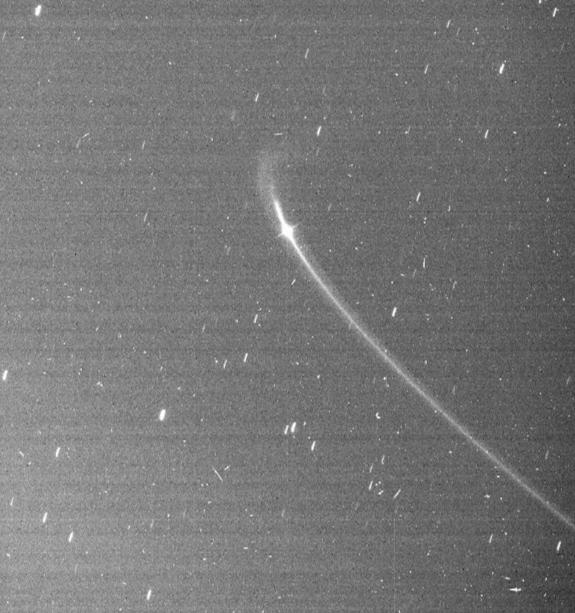
Posted by: Floyd Sep 10 2008, 11:28 PM
According to Ciclops http://ciclops.org/view/5259/Rev_84, on September 13th, "Cassini will then observe an arc of material in the G ring that was recently observed to have a denser clump of material within it."
We should know more soon. ![]()
Posted by: Floyd Sep 15 2008, 07:33 PM
I can't see any clumps of interest in the G-Ring images from September 13 & 14. The 13th's images are almost edge on and the 14th's have so much camera flair that I can't even find the G-ring. ![]() I'm sure the Cassini team can subtract out the flair, so there is probably good information somewhere in the images.
I'm sure the Cassini team can subtract out the flair, so there is probably good information somewhere in the images.
Posted by: Floyd Oct 29 2008, 02:01 AM
Some nice images of Ering which sure look a lot like the Gring. "Taken on October 27, 2008 and received on Earth October 28, 2008. The camera was pointing toward SATURN-ERING at approximately 1,199,543 kilometers away". I've seen pictures of the Ering with Enceladus embedded. This set of three has a nice moving clump--which made me think it the the Gring and clump. Looks like the Ering has both Enceladus and a clump. Open all three images in tabs and flip through to see the climp and stars move. ![]()
http://saturn.jpl.nasa.gov/multimedia/images/raw/casJPGFullS45/N00122496.jpg
http://saturn.jpl.nasa.gov/multimedia/images/raw/casJPGFullS45/N00122494.jpg
http://saturn.jpl.nasa.gov/multimedia/images/raw/casJPGFullS45/N00122493.jpg
Posted by: volcanopele Oct 29 2008, 03:44 AM
No, that's definitely the G ring. Not sure why it is labeled as the E ring though.
Posted by: ngunn Dec 10 2008, 09:46 AM
Nice bump with shadow:
http://saturn.jpl.nasa.gov/multimedia/images/raw/casJPGFullS46/N00125063.jpg
Posted by: Phil Stooke Dec 10 2008, 03:11 PM
A bit late - but that E-ring image is presumably labelled E-ring because it's centered on the E-ring. The label tells you what the camera is pointed at, regardless of what else might be in the image.
Phil
Posted by: ugordan Feb 2 2009, 02:28 PM
Again, a shot of the clump/moonlet in the G ring, slightly motion-smeared: http://saturn.jpl.nasa.gov/multimedia/images/raw/casJPGFullS47/N00128611.jpg
Not as obvious as some other shots, but it's still there and, apparently, persistent.
No official word on this yet?
Posted by: volcanopele Mar 3 2009, 08:55 PM
Tiny Moonlet Within G Ring Arc
http://ciclops.org/view/5493/Tiny_Moonlet_Within_G_Ring_Arc
The discovery of the G ring arc moonlet has been officially announced via a press release and an IAU Circular.
Posted by: stevesliva Mar 3 2009, 10:53 PM
...and I just read about it on Emily's blog.
How close are the G-arc flybys mentioned just recently here?
http://planetary.org/blog/article/00001857/
Has the first already happened? Doesn't sound like it will look like much even relatively close.
Posted by: volcanopele Mar 3 2009, 11:52 PM
The one in January 2010 is in the 10000-20000 km range (Celestia gives me ~14000 km). At that distance, S/ 2008 S 1 should be about 6 pixels across. The other would be in February 2017 at 20000-30000 km.
Posted by: elakdawalla Mar 3 2009, 11:57 PM
Huh, I didn't realize you could get that close to the G ring. Are there plans actually to attempt to image S/2008 S1?
Posted by: volcanopele Mar 4 2009, 12:05 AM
We are nicely out of the ring plane at the time, so it should be fine.
Posted by: nprev Mar 4 2009, 12:14 AM
Just restating congrats to Gordan for spotting this moonlet in what are probably the discovery images...what an eye!!! ![]()
Posted by: ustrax Mar 4 2009, 11:55 AM
Maybe I've missed something but are you saying that it was Gordan who spotted it first?...
made a gif out of the announcement images:
http://www.gifninja.com/Workspace/e6c3d462-09ef-44cb-801e-04c5647a3422/output.gif
Posted by: ugordan Mar 4 2009, 12:01 PM
I think Nick is referring to http://www.unmannedspaceflight.com/index.php?s=&showtopic=1151&view=findpost&p=123993. The raw image links apparently don't work anymore since the page redesign, but it's the same images as in the release.
Posted by: canis_minor Jan 23 2010, 05:59 AM
FYI next Wednesday is a close encounter to Aegaeon (closest until 2015), the parent body within the G ring. Close approach should be about 13,000 or so km and images will be taken near ~ 90 deg phase. I'm divided between thinking that these images will be vanilla, noisy images like many Cassini has taken before, or potentially spectacular. Should be worth a look though. Tracking pass begins 11:30PM UK time, 3:30PM Pacific. - Cheers.
Posted by: dilo Apr 27 2010, 10:42 AM
On April 18 Cassini made an interesting sequence of images of E-ring and main ring halo (see http://saturn.jpl.nasa.gov/photos/raw/?start=4&storedQ=2225395).
Using 3 consecutive clean-filter images with different exposures (W00063561/2/3), I made this false color "HDR" composition (red=darkest, blue=bright - solarization used too):
Posted by: stevesliva Aug 5 2010, 10:04 PM
Oddly, I think, the Cassini status noted this:
The S61 sequence concluded and S62 began execution today at 2010-211T18:51:00. The sequence will run for 37 days and conclude on Sept. 6. During that time there will be one targeted encounter of Enceladus and eighteen non-targeted flybys two each of Titan, Dione, and Epimetheus, and one each of Calypso, Atlas, Pandora, Daphnis, Janus, Pan, Tethys, Polydeuces, Telesto, Prometheus, G_ARC, and Aegaeon. Three OTMs are scheduled, numbered 259 through 261.
I thought 'G arc' and 'Aegaeon' would be the same thing??
Posted by: Hungry4info Aug 5 2010, 10:09 PM
Agaeon is a satellite, the G-arc is a ringlet.
Posted by: geckzilla Feb 2 2015, 05:08 AM
A quick, probably simple question... I wondered if this is a more or less correct guess: Are the E and G rings are kind of reflective or glossy like snowflakes? I see the way they are illuminated in the famous Saturn ring portraits and the bright points line up with the sun in the same way a glossy reflection would. The rings are of course made of many particles so the effect is diffuse and smooth. I circled what I am describing in the picture to ensure there is no confusion about what I am asking.
As a way to teach myself how to use Blender effectively I have been trying to copy various physical effects. I found that a good way to simulate the outer rings was with a hacked glossy material (I can't make a glossy volume...). My fake Saturn is http://www.geckzilla.com/astro/saturn_rings_render.jpg if you are curious. (If Björn Jónsson happens to read this, you are awesome and I thank you for providing all those image maps.)
Posted by: john_s Feb 2 2015, 03:09 PM
"Glossy" is the wrong word- that implies a specular (mirror-like) reflection. What's going on in this image instead is that there are small particles in the G and E rings which become particularly bright when the sun is almost directly behind them (in the same way that smoke is most conspicuous when backlit by the sun). The parts of those rings that are closest to being exactly backlit are the brightest, and those parts are close to Saturn, because the Sun is behind Saturn.
John
Posted by: geckzilla Feb 2 2015, 07:42 PM
John
That's what I thought at first, too. However, upon further reflection (har har) one must conclude that if that was the only effect at work, the shape of the highlights would take on a circular appearance which fades with distance from the light source rather than a vertical one which extends in brightness from the light source like a column. The sun is near the top edge of Saturn's limb (near the pole) in this picture. Its position is important to understand that the bottom portion of the rings are much brighter than one might anticipate for a circular halo extending evenly around the light source, even considering the variations in density. I do not understand why the bottom highlight is off center from the upper highlight but I suspect it has something to do with the probe's movement as it was making observations.
Posted by: geckzilla Feb 2 2015, 09:01 PM
Considering it again, perhaps it is more easily explained by refraction of light through hexagonal ice crystals rather than reflection. The glossy material in Blender may mimic this effect but the physics aren't the same. Either way, I had not considered the optical properties of the ring materials before exploring this matter through the simulation. We know the rings are composed of ice so it makes sense that hexagonal crystals would form, right?
Posted by: geckzilla Feb 4 2015, 09:36 AM
I spent a good number of hours today trying to figure out if my idea is unreasonable or ignorant. So far two people have told me that the E ring needs to operate something like a simple fog with the sunlight emanating evenly and roundly outward from the sun. I've searched and searched for some reference images other than the large mosaic and I've investigated the mosaic itself to understand better how much Cassini moved during the imaging process. The lower ring reflection does indeed coincide with the sun passing diagonally from the upper right to the lower left behind Saturn. That helps partially explain why the background portion of the ring is slightly brighter than the foreground portion and it also explains the movement. Moreover, I'm impressed with whoever put the mosaic together because it looks like a difficult job with lots of blown out white areas and yet the result is virtually seamless and hardly blown out at all as far as I can tell.
So my question is why do you think this, John? Is it just your intuition or is there some imagery I'm missing? Is there a previous discussion on this topic somewhere?
I'm feeling a very strong sense of deja vu as I write this post. I think I might just be nuts.
Posted by: hendric Feb 4 2015, 10:07 AM
Geck, on Earth ice crystals falling through the air can get aligned to form sundogs etc. I imagine there could be forces aligning the crystals at Saturn, but I don't think the environment is that benign, so to speak - look at how quickly spokes dissipate for example.
If you take your arc and make a circle with the brightest parts, I can believe that it is just a partial halo around the sun. I suspect there may be distance effects also, which cause the nearer rings to have a different sun->ring->camera angle than the further side.
Posted by: Gerald Feb 4 2015, 10:40 AM
Interstellar dust is thought to be polarizing (at radio wavelengths) due to precession along galactic magnetic field lines (http://www.rssd.esa.int/SA/PLANCK/docs/eslab47/Session04_Astrophysical_Results/47ESLAB_April_03_14_50_Boulanger.pdf).
Such partial alignment might occur near Saturn, too, due to its magnetic field.
Depending on the size and shape of grains around Saturn there may occur several types of scattering, most promising may be http://en.wikipedia.org/wiki/Tyndall_effect, provided the grains are smaller than about 1 micron.
You may check, whether Tyndall scattering of partially aligned, asymmetric or needle-shaped grains can cause asymmetric scattering patterns.
Posted by: geckzilla Feb 4 2015, 10:59 AM
Even randomly aligned ice crystals can create halo effects. I wasn't thinking they would be aligned but that would be neat if they did have any sort of alignment. I better look into more possibilities. Thanks for the suggestions.
Powered by Invision Power Board (http://www.invisionboard.com)
© Invision Power Services (http://www.invisionpower.com)
